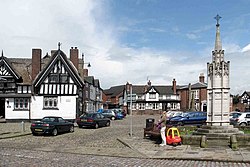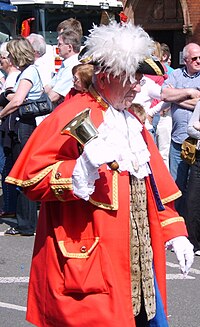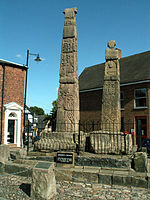Sandbach
| Sandbach | |
| Cheshire | |
|---|---|
 Sandbach | |
| Location | |
| Grid reference: | SJ755611 |
| Location: | 53°8’46"N, 2°22’1"W |
| Data | |
| Population: | 17,630 (2001) |
| Post town: | Sandbach |
| Postcode: | CW11 |
| Dialling code: | 01270 |
| Local Government | |
| Council: | Cheshire East |
| Parliamentary constituency: |
Congleton |
Sandbach is a market town in Cheshire. The civil parish of the same name contains four settlements; Sandbach itself, Elworth, Ettiley Heath and Wheelock.
Sandbach is perhaps best known as the original home of Foden and ERF lorries, though neither company now exists in the town, 12-times National Brass Band Championship winners, Foden's Band, the ancient Saxon Sandbach Crosses, and Sandbach services on the M6 motorway.
Name
The town's name is recorded as Sanbec in 1086, as Sondbache (also Sondebache) in 1260, and as Sandbitch in the 17–18th centuries,[1]
The name of Sandbach is from the Old English sand bæce, which can mean "sand stream" or "sand valley".[2]
History
Traces of settlement are found in Sandbach from Anglo-Saxon times, in particular the famous Sandbach Crosses standing in the town. Little is known about the town during this period, except that it was subjected to frequent Welsh and Danish raids.[3]
The town has an entry in the Domesday Book from 1086, at which time it was sufficiently large to need a priest and a church.[3] The entry states:
Sanbec: Bigot de Loges. 1 hide and 1½ virgates pay tax. Land for 2 ploughs. 1 Frenchman has ½ plough, 3 slaves. 2 villagers have ½ plough. Church. Woodland. Value TRE 4s; now 8s.[4]
By the 13th century, during the reign of King John, much of the land around the township of Sandbach was owned by Richard de Sandbach who was the High Sheriff of Cheshire in 1230.[3] Richard de Sandbach specifically owned a manor, he claimed an interest in the living of Sandbach. This claim against Earl Randle de Blundeville was unsuccessful. His son, Jon, however was slightly more successful as he won an 'interest' temporarily against the Abbot of Dieulacres only for it to be lost when it went to the Court of King's Bench.[5]

The manor in Sandbach passed through numerous families, including the Leghs and Radclyffes. It was eventually bought by Sir Randulph (or Randle) Crewe, who became the Lord of the Manor.
Sandbach has been a market town since 1579 when it was granted a Royal Charter by Elizabeth I at the petition of Sir John Radclyffe of Ordsall who, as the largest landowner in Sandbach and the owner of the Sandbach Old Hall, encouraged the farmers of the area to hold a market in the town on Thursdays.[6][7] The charter also allowed for right to establish a Court-leet and a Court of Pied-powder (the latter a market court).[5]
The original charter is still preserved, and can be found in Chester while a reproduction can be found in the Sandbach Town Council chamber at the Literary Institution. The charter also granted the town the right to hold two annual fairs, which lasted for two days, and were held around Easter and early September. Today the Thursday market is still held outdoors on Scotch Common, and in and around the Town Hall.[6]
Civil war and Commonwealth
During the Wars of the Three Kingdoms, a Scottish army swept down into England in support of King Charles II before being forced to retreat at the Battle of Worcester. On 3 September 1651 during Sandbach's summer fair, a Scottish army of around 1,000 exhausted cavalrymen passed through the town which army had been under the command of David Leslie.[3] The town was not an easy retreat route however, as the people of Sandbach and the market stallholders attacked the weary soldiers. A newspaper of the time said:
The dispute was very hot for two or three houres, and there were some townsmen hurt and two or three slaine, the Townesman slew about nine or ten and tooke 100 prisoners.[8]
This was the only notable event of the Civil War to have happened in Sandbach. As the fair and the fight took place on the common of the town, after this event the common gained the name Scotch Common.
Sandbach Ale
During the 17th century, the town used to be famous for its ale:
The ale brewed at this town was formerly in great repute in London, where, about the middle of the last century, it sold for twelve-pence a bottle, but it seems to be entirely supplanted by the Dorchester beer, and the Yorkshire and Welch ales, insomuch that we do not know of any Sandbach ale being now sold in the metropolis.[9]
And about 1621 William Webb writes that "Our ale here at Sandbach being no less famous than that [at Derby] of a true nappe".[10]
19th and 20th century
In 1836 Sandbach silk mills employed 554 people, including 98 boys and girls under 12 years old.[11] In 1801 the population was 1844, by 1851 this had reached 4659. Sandbach became a civil parish in 1866. The records from 1901 show a population of 5568. The Sandbach Corn Mill was a three-story brick building built in the late 19th century, on what is now Mill Hill Lane.[12]
Second World War
During Warship Week in December 1941, Sandbach adopted HMS Vimiera as its affiliated ship. The Vimiera was lost on 9 January 1942 when it was sunk by a mine in the Thames Estuary off East Spile Buoy[13] with the loss of 96 hands.[14]
Churches
Churches in the town include:
- Church of England:
- St John the Evangelist (Sandbach Heath)
- St Mary’s
- Baptist: Sandbach Baptist Church
- Methodist:
- Sandbach Methodist Church
- Sandbach Heath Methodist Church
- Roman Catholic: St Winefride’s
- Also nearby:
- Church of England:
- St Peter’s, Elsworth
- Christ Church, Wheelock
- St Philip’s, Hassall Green
- The Church on Ettiley Heath (jointly with Methodists)
- Methodist:
- Elworth Methodist Church
- Wheelock Methodist Church and
Sights of the town
Sandbach Crosses

Standing in the cobbled market square at Sandbach are two Saxon Crosses, known as the sandbach Crosses, that were reportedly built in the 7th, 8th or 9th century. The crosses are Scheduled Ancient Monuments.[15] A plaque near the crosses reads:
| “ | Saxon crosses completed in the 9th century to commemorate the advent of Christianity in this Kingdom of Mercia about AD 653 in the reign of the Saxon king Penda. They were restored in 1816 by Sir John Egerton after destruction by iconoclasts. | ” |
Listed Buildings
Sandbach also has many listed buildings, the buildings include Sandbach School, St Mary's Church, Sandbach and the Old Hall Hotel, Sandbach. Many of the local public houses, which were formerly stage coach stops, are listed, for example the Lower Chequer.
Many of the buildings of the town were designed by the renowned architect Sir George Gilbert Scott; he designed Sandbach Literary Institution, Sandbach School, St John the Evangelist's Church in Sandbach Heath and the Almshouses. He also restored St Mary's Church.[16]
Sandbach Flashes
Sandbach Flashes are a series of pools near the town providing nature sites, though they are not natural in themselves. The pools are formed by the subsidence of the ground due to brine extraction; the ancient industry of central Cheshire.
Natural England has designated a group of 14 separate areas,[17] as a "Site of Special Scientific Interest", described as:
- "a site of physiographical and biological importance. It consists of a series of pools formed as a result of subsidence due to the solution of underlying salt deposits [..] that show considerable variation in their plant and animal communities".[18]
At least 225 species of bird have been recorded on the Flashes.[19]
Economy
A partnership of groups forms the Sandbach Partnership, which is part of the South East Cheshire Enterprise (SECE).[20]
Sandbach is probably best known as the original home of both Edwin Foden, Sons & Co. and ERF lorries, both companies founded by members of the Foden family. Neither company now exists in Sandbach, having been taken over and production moved elsewhere. As of 2007 there is no trace of Fodens within Sandbach, with the former mansion home of the Foden family at Westfields being demolished to make way for a new council building. However, Foden's Brass Band, originally created for employees, is still based in Sandbach.
Sandbach has been a market town since 1579 when it was granted a Royal Charter by Elizabeth I.[6][7] Today the Thursday market is still held outdoors on Scotch Common, and in and around the Town Hall.[6] There is also a Farmers' Market which takes place on the second Saturday of each calendar month.[21] There are a number of shops and bars concentrated in the town centre.
Sandbach is now in large part a dormitory town for the adjacent conurbations centred on Manchester, Liverpool and even the Potteries of Staffordshire.[22] A large number of people work at the local council offices, which has its headquarters at Westfields.
There is light industry, manufcturing and warehouses at Millbuck Industrial Area.
Culture
Sandbach has an annual transport festival which usually takes place during April. It originally started in 1992 as 'Transport through the Ages parade', and was such a success that it became an annual event; since its inception it has been run alongside the National Town Criers' competition.[23] The Festival is run by an organising committee made up of local councils and volunteers.[24]
Foden's Brass Band is still based in the town, despite the truck manufacturer from which it derives its name no longer having a presence. In 2008 Foden's became British Open Brass Band Champions.[25]
Sandbach Voices is a local choir that was founded in 1947 and is a registered charity.[26] The choir's mission is to bring choral music into the community, and it regularly stages concerts, often in Sandbach Town Hall or at St Mary's Church.
Sandbach Concert Series[27] features classical, jazz and brass music.
At the end of November every year the Christmas lights are turned on by the chairman of the town council.[28]
Media
Five local newspapers are distributed in Sandbach:[29] the Chronicle (Sandbach edition), published on Wednesdays, the Sandbach Chronicle on Thursdays, Crewe Guardian on Thursdays, the South Cheshire Advertiser,[29] and the daily Sentinel (Cheshire edition).
South Cheshire is served by BBC Radio Stoke.[30] It is also in the broadcast area of Cheshire FM, Macclesfield based Silk FM and Stoke-on-Trent-based Signal 1 and Signal 2.
Big Society
Cadets
1873 (Sandbach) Sqn is the local squadron of the Air Training Corp. Founded in 1952, it is part of Staffordshire Wing and the West Midlands Reserve Forces.[31] Sandbach Army Cadet Force is based in the Old TA Centre.[32] Sandbach Fire Station Cadets consists of around 20 young people and meet every Tuesday evening.[33] The Combined Cadet Force (CCF) is based at Sandbach School.
Sport
- Cricket: Sandbach Cricket Club
- Football: Sandbach United Football Club
- Rugby Union: Sandbach RUFC
- Golf: there are two golf clubs:
- Sandbach Golf Club, founded in 1895 (9-hole)
- [http://www.congleton.gov.uk/?t=229 Malkins Bank Golf Course (18-hole municipal)
Sandbach Leisure Centre is on Middlewich Road and is run by the council.
Outside links
- Sandbach Town Council
- Sandbach - Ancient Market Town
- Cheshire Market Towns
- Sandbach United Football Club
- Sandbach United Community Football Centre
- Sandbach Town Guide at Sandbach Town Council
- "Sandbach" Pigot & Co.'s Directory of Cheshire (1828–29)
- "Sandbach" Kelly's Directory of Cheshire, 1902
References
- ↑ Daniel King, William Smith, William Webb, The history of Cheshire: containing King's Vale-Royal entire, printed by John Poole, 1778
- ↑ Nicolaisen, Gelling & Richards, The Names of Towns and Cities in Britain, p. 168
- ↑ 3.0 3.1 3.2 3.3 "General info". http://www.coldmoss.co.uk/html/general_info.html. Retrieved 2008-08-28.
- ↑ "The Domesday book online". http://www.domesdaybook.co.uk/cheshire2.html. Retrieved 2008-06-27.
- ↑ 5.0 5.1 Sandbach Official Guide 1970
- ↑ 6.0 6.1 6.2 6.3 "Market". www.sandbach.gov.uk. http://www.sandbach.gov.uk/Guide/Market.htm. Retrieved 2008-08-26.
- ↑ 7.0 7.1 "Old Hall History". SOHAG- Save the Old Hall Action Group. http://www.sandbacholdhall.org/Index.Html. Retrieved 2008-08-26.
- ↑ "A Brief History of Sandbach". http://www.sandbach.gov.uk/Guide/History.htm. Retrieved 2008-06-27.
- ↑ A description of England and Wales, Volume 2, printed for Newbery and Carnan, 1769.
- ↑ Daniel King, William Smith, William Webb (gentleman.), The history of Cheshire: containing King's Vale-Royal entire, printed by John Poole, 1778.
- ↑ James Wheeler, Manchester: its political, social and commercial history, Published 1836. 540 pages.
- ↑ Owen Ashmore, The industrial archaeology of north-west England, Manchester University Press ND, 1982, ISBN 0-7190-0820-4, ISBN 978-0-7190-0820-7
- ↑ http://www.roll-of-honour.com/Durham/TowLaw.html
- ↑ http://www.naval-history.net/xDKCas1942-01JAN.htm
- ↑ National Monuments Record: No. 74749 – Sandbach Crosses
- ↑ "Buildings". www.sandbach.gov.uk. http://www.sandbach.gov.uk/Guide/Buildings.htm. Retrieved 2008-08-26.
- ↑ "Sandbach Flashes", South East Cheshire Ornithological Society
- ↑ "Sandbach Flashes", at naturalengland.org.uk
- ↑ Andrew Goodwin and Colin Lythgoe, The Birds of Sandbach Flashes 1935-1999, 128 pages (description at South East Cheshire Ornithological Society)
- ↑ Sandbach Parnership website
- ↑ "Sandbach Town Council website". www.sandbach.gov.uk. http://sandbach.gov.uk/farmers-market/. Retrieved 2010-10-24.
- ↑ "Visit Cheshire website". www.visitcheshire.com. http://www.visitcheshire.com/site/places/towns-and-villages/sandbach-p33801. Retrieved 2010-10-24.
- ↑ "Transport". www.sandbach.gov.uk. http://www.sandbach.gov.uk/Guide/Transport.htm. Retrieved 2008-08-26.
- ↑ Home
- ↑ "Fodens take British Open Crown". fodensband.co.uk. 2008-09-15. http://www.fodensband.co.uk/shop/news.php?article=33&osCsid=030f557e255871a9da94044fbb09e4c7. Retrieved 2008-12-29.
- ↑ Sandbach Voices Official Website
- ↑ Sandbach Concert Series website, retrieved 24 Oct 2011
- ↑ "Lights". www.sandbach.gov.uk. http://www.sandbach.gov.uk/Guide/Lights.htm. Retrieved 2008-08-26.
- ↑ 29.0 29.1 "Local Newspapers". www.sandbach.gov.uk. http://www.sandbach.gov.uk/Guide/Newspapers.htm. Retrieved 2008-08-26.
- ↑ "BBC Stoke and Staffs". BBC. http://www.bbc.co.uk/stoke/radiostoke/. Retrieved 2008-08-26.
- ↑ 1873 (Sandbach) Sqn, history
- ↑ "Sandbach" Army Cadet Force Cheshire website
- ↑ "Sandbach Fire Station Cadets", Cheshire Fire & Rescue Service website
Books
- Nicolaisen W. F. H., Gelling M., & Richards M. (1970). The Names of Towns and Cities in Britain. B. T. Batsford Ltd. ISBN 0-7134-0113-3.
- Earwaker J.P. (1890). The History of the Ancient Parish of Sandbach, Co. Chester including the two chapelries of Holmes Chapel and Goostrey from original records..